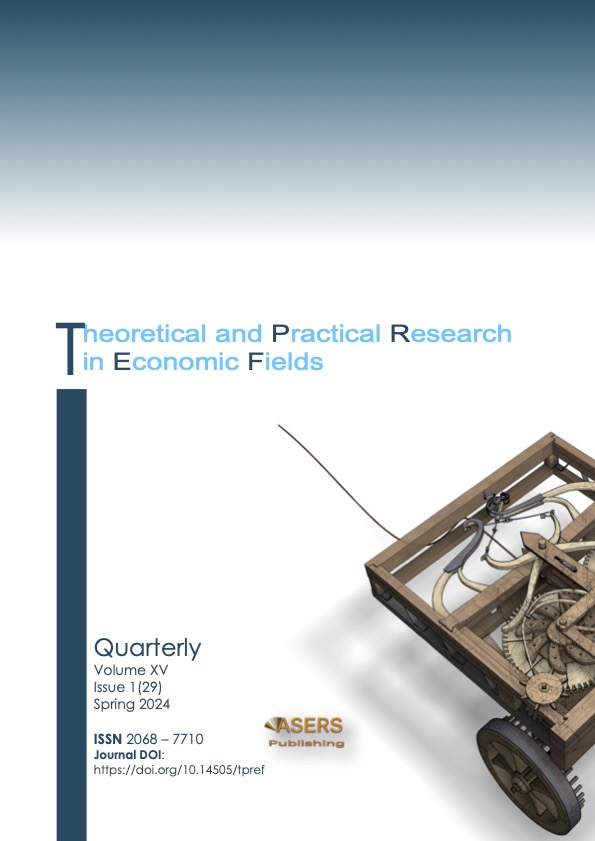Economics of Fiscal Dominance and Ramifications for the Discharge of Effective Monetary Policy Transmission
Abstract
This paper explores the intricate dynamics of fiscal dominance and its profound implications for monetary policy efficacy, contributing to the discourse on the interplay between fiscal and monetary policies. The theoretical foundation critically examines existing literature, integrating empirical evidence to construct a comprehensive understanding. Model blocks strategically elucidate the significance of fiscal variables in shaping monetary transmission mechanisms. The ensuing analysis scrutinises the disruptive potential of fiscal dominance on conventional monetary policy tools. The conclusion navigates policy recommendations, emphasising the necessity of coordinated fiscal-monetary strategies to effectively mitigate inflationary pressures. This research provides a nuanced perspective for policymakers, offering theoretical depth and empirical insights to guide decisions in addressing the complex challenges posed by fiscal dominance in economic governance.
References
[2] Blanchard, O. 2019. Public Debt and Low Interest Rates. American Economic Review, 109(4): 1197-1229.
[3] Diallo, I. and Mendy, I. 2018. Fiscal dominance in the West African Monetary Zone: An empirical investigation. West African Journal of Monetary and Economic Integration, 18(1): 21-46.
[4] Famous, A., and Claeys, G. 2020. The Evolution of European Economic Institutions during the COVID 19 Crisis. Eur Policy Anal., 6: 328-341. DOI: https://doi.org/10.1002/epa2.1100
[5] Hanif, M., and Arby, M. 2003. Monetary and fiscal policy coordination. Munich Personal RePEc. No. 10307.
[6] Hofmann, B, Lombardi, M.J, Mojon, B., and Orphanides, A. 2021. Fiscal and Monetary Policy Interactions in a Low Interest Rate World. CEPR Discussion Paper No. DP16411. Retrieved from SSRN: https://ssrn.com/abstract=3928690
[7] Jackson, E.A. 2016. Phronesis and Resource Curse Hypothesis in Post-Independent Sierra Leone, Ilorin Journal of Economic Policy, Ilorin Journal of Economic Policy, Ilorin, 3: 1-11.
[8] Jackson, E.A., Barrie, M.S. and Tamuke, E. 2023. Effectiveness of the Interest Rate Channel of Monetary Policy Transmission Mechanism in Sierra Leone. MPRA Papers. 117478.
[9] Jazbec, B., and Banerjee, B. 2017. Rethinking monetary-fiscal policy coordination. Proceeding of a seminar jointly organised by the Bank of Slovenia and the IMF. Ljubljana: Bank of Slovenia. Imf.org. Available at: https://imf.org/external/np/seminars/eng/2016.pdf
[10] Kinda, T, Andras L, and Kaustubh C. 2022. Fiscal Multipliers during Pandemics. IMF Working Paper No. 2022/149.
[11] Mawejje, J., and Odihambo, N.M. 2022. The determinants of cyclicality of fiscal policy: Empirical evidence from East Africa. International Economic, 169: 55-70. DOI: https://doi.org/10.1016/j.inteco.2021.12.001
[12] Sharma, V., Fatima, S., Alam, Q., and Bharadwaj, Y.P. 2023. Modelling the role of fiscal and monetary policy instruments on carbon emission in non-linear framework: A case of emerging economy. International Social Science Journal, 73(248): 435-461. DOI: https://doi.org/10.1111/issj.12413
[13] Tomsik, V. 2012. Some Insights into Monetary and Fiscal Policy Interactions in the Czech Republic. BIS Paper No. 67j. Available at: https://ssrn.com/abstract=2205639
[14] Warburton, C. E., and Jackson, E. A. 2020. Monetary Policy Responses to Exogenous Perturbations: The Case of a Small Open Economy (2007-2018). PSL Quarterly Review, 73(293): 181–201. DOI:https://doi.org/10.13133/2037-3643_73.293_5
[15] Warburton, C.E.S., Jackson, E.A. 2023. The Econometrics of Factor Loadings and Implications for Monetary Policy in a Small Open Economy (2005-2020)-Sierra Leone. Journal of Economic Policy Researches, 10(1): 19-35. DOI: https://doi.org/10.26650/JEPR1082693
Non-Exclusive License under Attribution 4.0 International Public License (CC BY 4.0):
This ‘Article’ is distributed under the terms of the license CC-BY 4.0., which lets others distribute, remix, adapt, and build upon this article, even commercially, as long as they credit this article for the original creation. ASERS Publishing will be acknowledged as the first publisher of the Article and a link to the appropriate bibliographic citation (authors, article title, volume issue, page numbers, DOI, and the link to the Published Article on ASERS Publishing’ Platform) must be maintained.
